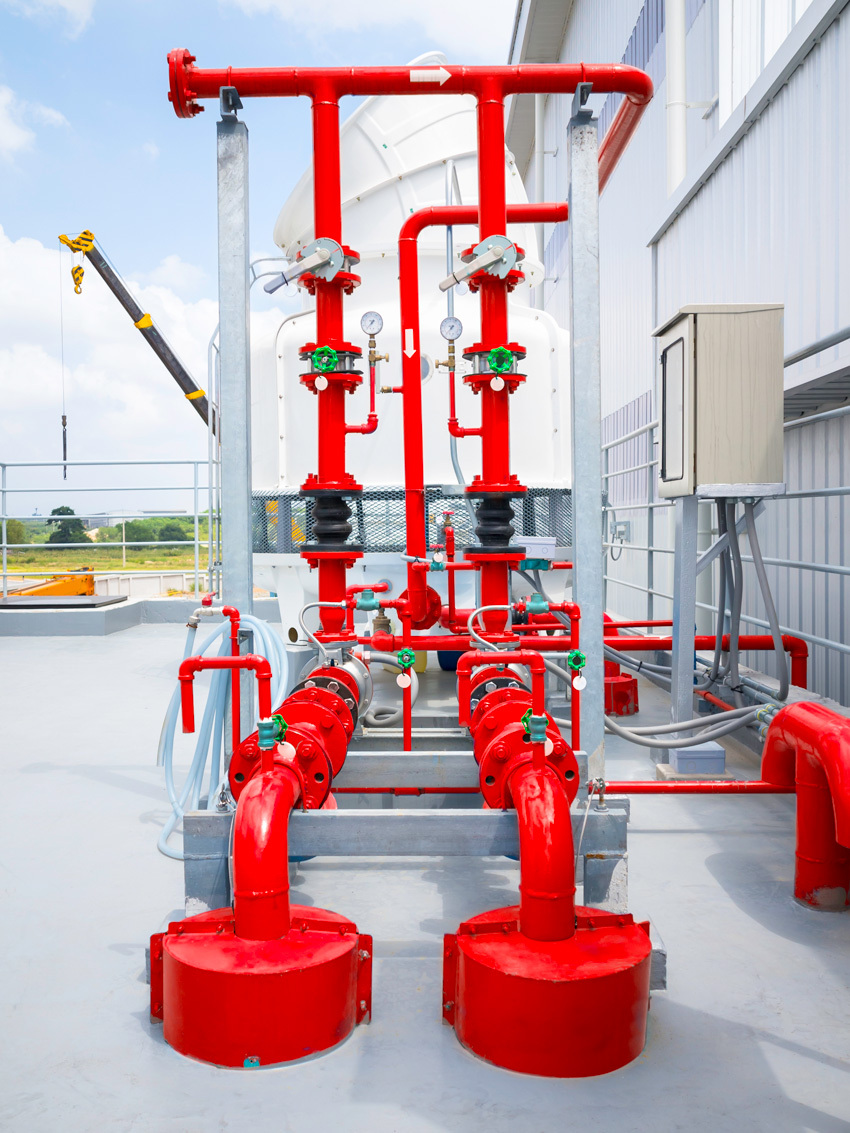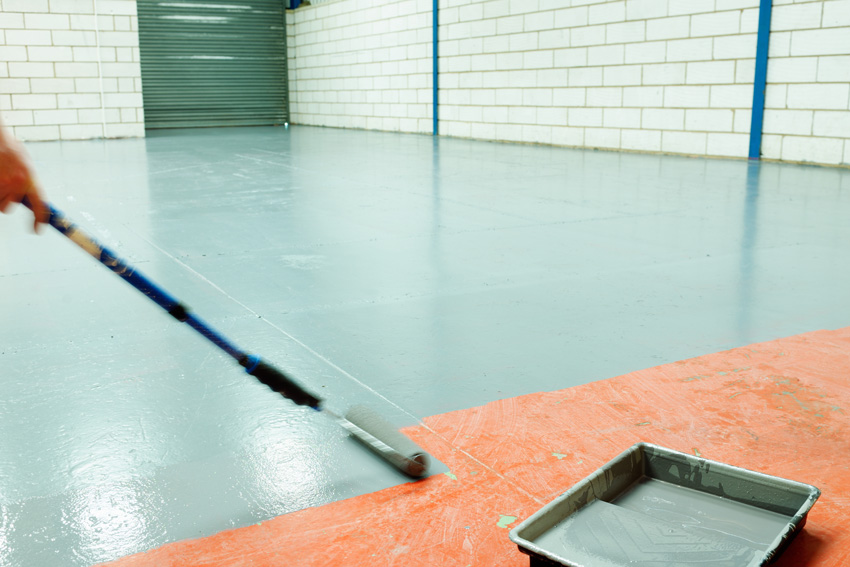An Introduction to High-Performance Coating Systems (Article Course)
Why, Where, and How High-Performance Coatings Are Used
In the previous section, we established the basics about high-performance coatings, but let’s dig deeper into why, where, and how these coatings are used.
Why are High-Performance Coatings Used?
High-performance coatings serve three primary purposes: protection, performance, and aesthetics. Protection, for example, can refer to the coating’s ability to protect the substrate from the elements, such as moisture, dirt and dust, and sun exposure. It also can refer to protecting the substrate against chemical exposure and abrasion. That protection, in turn, ensures that the substrate underneath remains as durable and safe as possible, whether that material is metal, masonry, concrete, or drywall.
Construction materials are used to meet specific needs, and each has different limitations. Steel, for example, is one of the most commonly used materials in construction projects, and it is critical that it resists corrosion. High-performance coatings protect steel and other metals by creating a highly durable barrier between the metal and its service environment. Architectural paints cannot provide that level of protection or performance. Concrete, cement, and brick masonry are also vulnerable to chipping and cracking. However, when they are properly primed and coated, they become better protected from a potentially damaging environment. Drywall, which is commonly used in many architectural projects, is limited in that it easily can be damaged by impact if painted with a standard architectural coating. A high-performance coating, on the other hand, can add a level of durability from light scuffing that is quick and easy to clean while simultaneously adding a pop of color to the surface.
Where are High-Performance Coatings Used?
An easy way to think about where high-performance coatings might be useful is to go back to the answers to the “why questions” above. That is, these coatings are used on surfaces that require exceptional durability against abrasion and physical use, or protection from corrosion or chemicals. At first glance, structures such as bridges and industrial sites come to mind, and they are indeed one of the main places where high-performance coatings are necessary. Some out-of-the-box thinking, however, can reframe the need for exceptional durability to see that high-performance coating systems are not limited to industrial and mechanical purposes. In fact, there are many nonindustrial projects where high-performance coatings are preferable over architectural coatings, including hotels, retail, and commercial spaces to educational and health-care facilities—the opportunities are endless.
Let’s step outside of the large-scale, industrial-only box and look at a few examples of where these coatings can make a drastic difference in the longevity of structures and surfaces, and where they can improve the spaces and structures.
A common view is that high-performance coatings are limited to projects such as offshore oil platforms or other large-scale industrial structures that are subject to harsh environmental conditions. Oil platforms, for example, do face extreme environments with constant exposure to moisture, salt spray, and high winds, and a high-performance coating is critical to reducing the rate of corrosion. But such environmental conditions are not unique to the middle of the ocean. Commonplace structures such as the metal cooling towers that are on top of almost every mid- to high-rise building in a city, for example, are subjected to UV rays, rain, snow, wind, and other weather challenges. These towers also have water running through them at all times so they are subject to interior and exterior corrosion. There are hundreds, if not thousands of these water towers in any given urban area, and every single tower needs a high-performance coating. All it takes is to look around to see metal and concrete structures that can benefit from the protective characteristics of a high-performance coating system.
Other projects, typically considered architectural, such as hospitals, healthcare facilities, restaurants, retailers, and hotels or, for that matter, any place that gets a lot of use and needs to be kept clean and safe, is a candidate for high-performance coatings. Most of these spaces include kitchen areas that need to be spotless for health and safety codes and retail spaces that need to ensure floors and walls are kept clean and presentable. The primary purpose of high-performance coating systems is protection—creating surfaces that are not easily destroyed by harsh cleansers or during decontamination processes in facilities like hospitals, restaurants, and nuclear plants that have to be cleaned regularly with harsh chemicals.
Sporting arenas or ballparks are yet another example where high-performance coating systems can be applied. Picture a ballpark, with tens of thousands of feet of metal railings that need to be painted for aesthetic appeal, to protect the metal, and to protect the patrons. Chipped paint or rust flakes can be injury hazards, and so these railings require a durable and long-lasting coating that will help ensure that the facility is a safe place. And, with thousands of feet of railings, the facility will benefit from using a product that is easy to apply and quick to dry. Another use for high-performance coatings may be on flooring in arenas and parks; a durable, nonslip coating can help reduce foot-traffic accidents, especially in venues where food and beverages are sold (and often spilled) or that have outdoor seating exposed to harsh weather.
The examples above include areas that get frequent daily use from people; however, there are also spaces that are exposed to the wear and tear of construction equipment and heavy machinery, such as warehouses. Such spaces can benefit from high-performance coatings on everything from floors that are subjected to the metal of a scraping forklift or abrasion from the lift tires to oil, fuel, and material spills. Warehouses also have internal supports such as poles and walls that may get bumped or scraped from incoming trucks or other small industrial vehicles. All of these spaces can benefit from a high-performance coating system.
Spaces such as building maintenance and facilities rooms also contain structures that require high-performance coatings. Although the structures vary from building to building, they all include tanks and pipes that need to be color-coded with a durable chemical and corrosion-resistant paint. Color coding makes it easy to differentiate the pipes, and a high-performance coating simultaneously contributes to protecting whatever is contained in the pipe or tank from the exposure to the elements, while also assisting in protecting the environment from whatever is contained in the pipes.

Color coding makes it easy to differentiate the pipes, and a high-performance coating simultaneously contributes to protecting whatever is contained in the pipe or tank.
What Is a High-Performance Coating System?
High-performance coatings typically rely on a multilayered approach, although there can be some variation depending on the substrate and project. After proper and complete preparation, the basic steps include a primer, an intermediate coat, and a finish coat. Primers are designed to adhere to the surface and provide additional corrosion resistance. Different substrate materials and conditions require different primers. In some situations, it may be used to drive out moisture from the substrate and to help inhibit rust and corrosion in a metal structure or pipes. The coating system, regardless of the intended use or service environment, needs to be applied to a properly prepared substrate. Surface preparation should be the best allowable under project conditions and be appropriate for the coating system being applied.
Even with a primer, most substrates need more than just one additional coat of paint and so require an intermediate layer. There are two main reasons why this second layer is necessary. First is that paint is measured in “mils,” which are 1/1000 of an inch. A typical coat of paint yields about 1 mil to 3 mils per coat, which is a very thin layer that does not offer much protection; an added layer makes a big difference. Second, all applied coatings may have pinholes, which are pathways for water and chemicals. Additional coating layers reduce the possibility that the pinholes in subsequent layers line up, thus potentially eliminating these paths to the substrate for water or chemicals.
The top coat—or finish coat—provides additional protection but also is used for aesthetics. Coating aesthetics can range from color-coded pipes in an industrial or maintenance facility to sports teams’ colors throughout an arena or a school’s colors on the hallway walls, gymnasium, or cafeteria. The top coat also may be used to finish the surface with a high gloss that is easier to clean and potentially more abrasion resistant than lower sheen coatings.
In general, most residential and commercial projects require a coating system that includes one coat of primer and two additional top coats. Industrial applications, however, may require specialized primer followed by a specific intermediate coat and then a top coat. Regardless of the application, the logic behind this three-coat layering system is the same: to maximize protection and performance of the coating and to extend the longevity of the substrate. The layers work together to protect the substrate—it’s not always about thickness; it’s about the layering.

Multi-coating, or laying, works to maximize protection and performance of the coating and to extend the longevity of the substrate. The layers work together.
A final note about layering: Coating manufacturers formulate their products to work together to ensure optimal performance, so it is important to specify a coating system from a single manufacturer and not mix and match.
When it comes to thinking about how to use high-performance coatings for a project, there are two approaches to consider: bottom up and top down. The bottom-up approach starts with the substrate and works upward to the coating by considering the type of preparation and coating requirements for the substrate. The top-down approach, on the other hand, starts with the coating goal (e.g., aesthetics or performance) and works down to the substrate, considering what issues the substrate may encounter in the space (e.g., moisture, salt, chemicals). Both approaches are equally important and should be used together to get the full picture of what the physical, performance, and aesthetic requirements are for the substrate and thus for the coating.










